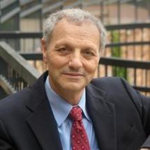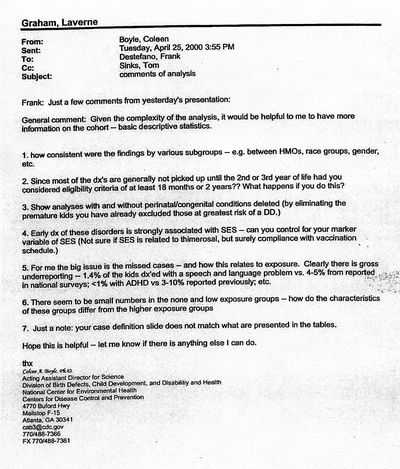
Fraudulent studies DeStefano Thorsen, Poul [Pediatrics. February 2004] Age at First Measles-Mumps-Rubella Vaccination in Children With Autism and School-Matched Control Subjects: A Population-Based Study in Metropolitan Atlanta. Frank DeStefano, Tanya Karapurkar Bhasin, William W. Thompson, Marshalyn Yeargin-Allsopp, Coleen Boyle
CDC Frauds: Connections Between the DeStefano Paper and the Thorsen Affair.

Frank Destefano
By John Stone http://www.ageofautism.com
Last week a Centers for Disease Control employee, William Thompson, came forward as whistleblower to admit that a 2004 study led by Frank DeStefano, of which Thompson himself was co-author was fraudulent, disguising the fact that incidence of autism was three and a half times higher in African Americans vaccinated with MMR before 36 months. In this light it is interesting that another co-author of the study, Marshalyn Yeargin-Allsopp, also liaised with Poul Thorsen over commissioning the equally fraudulent Madsen MMR/autism study. Thorsen who coordinated a series of studies between the CDC and Aarhus University/Staaten Serum Institut, Denmark was indicted in 2011 in the US on 13 counts of wire fraud involving the CDC and 9 of money laundering , but no attempt has been made to extradite him from Denmark.
None of the studies coordinated and co-authored by Thorsen have ever been retracted. At a congressional hearing in 2012 Coleen Boyle, another CDC employee and another co-author of the fraudulent DeStefano paper, failed to give straight answers when questioned by congressman Posey about Thorsen. Boyle could only recall two studies co-authored by Thorsen when in fact there were at least 21. On that occasion Congressman Posey memorably referred to Thorsen as “a humongous scum bag and one of the most wanted men on earth” .
If Cochrane 2005 smelt a rat with DeStefano 2004:
The conclusion, however, implied bias in the enrollment of cases which may not be representative of the rest of the autistic population of the city of Atlanta, USA where the study was set.
it actually stated there was a rat in the case of Madsen:
The follow up of diagnostic records ends one year (31 Dec 1999) after the last day of admission to the cohort. Because of the length of time from birth to diagnosis, it becomes increasingly unlikely that those born later in the cohort could have a diagnosis.
To put it more bluntly Madsen had included in the vaccinated group children who were too young to be vaccinated and children who were too young to have been diagnosed. The data was subject to review in two articles published Journal of American Physicians and Surgeons, one by Goldman and Yazbak, the other by Stott, Blaxill and Wakefield with differing results but both detecting a hoard of missing autism cases among the vaccinated implicit in Cochrane (actually published afterwards). Notable was the suppressed 2002 letter to NEJM from Prof Suissa, an epidemiologist from McGill, published in the Stott article which recalculated the Madsen data to suggest that autism was 45% higher in the vaccinated group. Brian Hooker also contributed to the correspondence in the following issue.
We may never know exactly what was the surplus of autism cases in the vaccinated group, except that it was evidently going to be substantial.
But also we need to bear in mind the conspiratorial circumstances in which the Madsen study was commissioned, which involved co-author of the DeStefano study Marshalyn Yeargin-Allsopp who wrote in an email (May 30, 2000 2.36pm) to Jose Cordero , at the time deputy head of the National Immunisation Program (NIP):
Jose,
As we discussed on Friday, we have become aware through Poul Thorsen of an exciting opportunity to study the role of MMR vaccine and autism using several registries/existing studies and the repository of biologic specimens and laboratory capabilities in Denmark. Attached below is a proposal for such a study. Poul will be leaving on Thursday to travel to Denmark where he will be meeting with the PIs (Principle Investigators) for the proposed study on June 6th. We would like to be able to have Poul say whether it is likely that CDC (NIP) can fund the study, if NIP is interested. The proposed budget is included; there may be additional sources of funding (in addition to NIP) but we are not certain at this time. Unfortunately, the DD Branch does not have much (if any) $$ to fund the study, but we do have the expertise that we have developed due to the autism surveillance in Atlanta and the MMR/autism casecontrol study. I will be out of the office tomorrow, but you may contact Diana or Poul if you have questions. Thank you so much for considering this proposal.
Marshalyn
There would be no sense in Yeargin-Allsopp approaching the vaccine compliance division of the CDC – which had no remit to research the causes of autism - to fund the study unless the conclusions were already guaranteed to be favourable to the program. Today, Cordero who funded the Madsen paper via Thorsen and Yeargin-Allsopp sits on the Interagency Autism Coordinating Committee along with Coleen Boyle, although Yeargin-Allsopp seems to have recently retired from it.
These events were subject to meticulous scrutiny in articles by Ed Yazbak ‘The CDC finances, writes and helps publish Danish research: another useless CDC-supported autism study’ and ‘The CDC, Spinach and Autism’ .
We must certainly consider that these frauds are part of the same story.
John Stone is UK Editor for Age of Autism.
Addendum
In an email from Coleen Boyle to Frank DeStefano regarding thimerosal and autism (reported in AoA in 2012) Boyle poses the question:
... "2. Since most of the dx's are generally not picked up until the 2nd or 3rd year of life had you considered eligibility criteria of at least 18 months or 2 years?? What happens if you do this?" ....
It is interesting to note that this is exactly what they did with the Madsen (MMR) paper which was well into the planning stage when Yeargin-Allsopp wrote to Cordero just five weeks later. It looks as if this had already been identified as a way of hiding the effect. An advantage of carrying out such a study in Denmark was that diagnosis was generally much later than in the United States.
